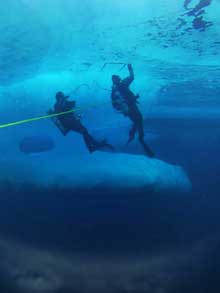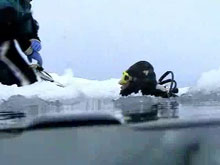
Ice divers use a quadrat to study the density of creatures living on the underside of ice floes. Their research has shown higher densities of amphipods and other creatures in under ice areas with more physical relief; the little holes and crevices in the ice provide habitat and protection from predators.
![]()
![]() Experience
what it is like to be an Ice diver studying the density of creatures
living on the underside of ice floes. (mp4,
1.06 MB) Click image or link for video.
Experience
what it is like to be an Ice diver studying the density of creatures
living on the underside of ice floes. (mp4,
1.06 MB) Click image or link for video.
Under-Ice Habitats
July 11, 2005
Katrin Iken
Assistant Professor Marine Biology
School of Fisheries and Ocean Sciences
University of Alaska Fairbanks
"Another deep breath, then hold your breath..." I am thinking while I take in a gulp of cold air from my dive regulator and swim to the location where my dive buddy, Elizabeth Calvert, patiently holds a quadrat (a square used to take measurements) against the ice surface above her. I am holding my breath so my exhaling air bubbles do not disturb the animals sitting on the icy surface within the quadrat.
The Arctic sea ice is an amazing habitat for many very small algae and animals that make a living in the network of so-called brine channels in the sea ice. But there are also a few larger animals living with the sea ice. These are mainly amphipods, little crustaceans up to an inch in length, and some fish, mostly Arctic cod. One goal of our expedition is to better understand how these larger animals use the underside of the sea ice as habitat. Our scientific dive team plunges into the freezing Arctic water at each station to analyze this habitat. Identifying and counting amphipods within a quadrat of defined size makes it possible to estimate the density of these animals.
Counting is easy today because our ice floe is very flat at the underside. We have noticed the amphipods do not occur in very high densities at very flat and smooth surfaces, most likely because there are not enough little holes and crevices in the ice for them to hide from predators like fish and diving birds. So, this is a short dive, and while the results are very interesting for our project, we are a little disappointed to not have seen more of the amazing ice structures formed by pressure ridges. Pressure ridges are created when ice floes are pressed together and ice piles at the edges of the floes. The broken pieces refreeze and form large underwater structures, which build a highly three-dimensional habitat for the animals we are investigating.
Later in the day, our dive team performs another set of dives on one of these pressure ridges. As we expect by now, we find a much higher variety and density of amphipods here than on the flat underside of the previous ice floe. After another successful quadrat count dive with Elizabeth along the diverse ridge structures it is time to collect some of these animals. Apart from their presence with relation to the physical ice structures, we are also interested in the role the amphipods play in the Arctic food web. Shawn Harper, our third dive team member gets in the water with me, a sampling bag with jars and plastic bags dangling from his waist. Chasing amphipods keeps us warm, but fortunately, the amphipods are not very fast swimmers and we catch a sufficient amount. On our way back to the ice edge, we see a small Arctic cod feeding on some amphipods under the ice. After several failures, we manage to catch the small fish in our net and return to the surface, cold but satisfied with our day's work.
Sign up for the Ocean Explorer E-mail Update List.

































